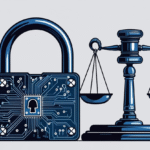Executive Summary
The European Union Artificial Intelligence Act (EU AI Act), effective August 1, 2024, is the world’s first comprehensive regulatory framework for artificial intelligence. Its extraterritorial reach and risk-based structure not only bind European companies but also apply to U.S. firms whose systems or services impact EU residents. This post explores the EU AI Act’s implications for American law, business practices, and public policy, examining how Europe’s regulatory leadership is catalyzing a shift in U.S. AI governance.
Introduction
AI systems are rapidly transforming global industries, from healthcare and finance to national security and education. While the U.S. has long led in technological innovation, it lags in comprehensive AI regulation. The EU AI Act changes that balance, creating external pressure on American lawmakers and companies to respond.
Overview of the EU AI Act
The EU AI Act regulates AI systems by categorizing them into four risk tiers:
- Unacceptable Risk: Banned (e.g., social scoring, manipulative biometric surveillance).
- High Risk: Heavily regulated (e.g., AI in hiring/HR, credit scoring, critical infrastructure).
- Limited Risk: Subject to transparency obligations (e.g., AI chatbots).
- Minimal Risk: Largely unregulated (e.g., AI in games).
It includes special rules for General-Purpose AI (GPAI) systems and imposes extraterritorial obligations, meaning any AI system that affects the EU market is within scope.
Extraterritorial Applicability to U.S. Businesses
Under Articles 2 and 3 of the Act, U.S.-based entities are subject to compliance if they:
- Deploy AI systems within the EU market.
- Produce outputs from AI systems that are consumed by EU individuals.
- Serve as importers, distributors, or deployers of AI systems within the EU.
Key sectors impacted include:
- Healthcare (e.g., AI-assisted diagnostic platforms)
- Finance (e.g., algorithmic lending and credit scoring)
- Human Resources Technology (e.g., AI in hiring and performance evaluations)
- General-Purpose AI Providers (e.g., foundation models and generative systems)
Violations may incur administrative fines up to €35 million or 7% of annual global turnover, whichever is higher.
U.S. Legal and Policy Response
Federal Developments
- President Biden’s 2023 Executive Order on Safe, Secure, and Trustworthy AI laid the groundwork for ethical AI governance.
- Multiple legislative initiatives, such as the Algorithmic Accountability Act and the Digital Platform Commission Act, are under consideration.
- Growing bipartisan interest in establishing a centralized AI oversight authority reflects increasing alignment with European regulatory models.
State-Level Legislation
- Colorado’s 2024 Artificial Intelligence Act emulates key elements of the EU framework, including risk classification and human oversight requirements.
- More than 550 AI-related bills have been introduced across 45 states, focusing on biometric data governance, automated decision-making, and consumer transparency.
The Brussels Effect in AI Governance
A phenomenon first conceptualized by Anu Bradford, the “Brussels Effect” explains how EU regulations often become de facto global standards. U.S. tech firms, including Microsoft, OpenAI, and Salesforce, are proactively aligning with EU AI norms. For example:
- Microsoft and Mistral have endorsed the EU’s Code of Practice for GPAI.
- Meta Platforms, Inc. has publicly declined participation, citing concerns about regulatory overreach and innovation constraints.
The general purpose of this alignment is to help large businesses maintain consistent compliance practices across the global markets.
Strategic Implications for U.S. Policymakers
The EU AI Act serves as a catalyst for regulatory introspection within the United States. Emerging policy proposals reflect consideration of:
- A harmonized, tiered risk model for AI regulation.
- Mandatory documentation, auditability, and human-in-the-loop protocols.
- International cooperation mechanisms to support AI safety and global competitiveness.
Absent federal action, the U.S. risks regulatory fragmentation and diminished influence over global AI norms.
Challenges and Critiques
- Innovation Concerns: Critics argue the EU framework may stifle innovation by imposing prescriptive obligations.
- Economic Disparities: Small and midsized businesses face disproportionate compliance burdens.
- Sovereignty and Political Resistance: Prominent U.S. legislators have warned against “outsourcing” American AI policy to foreign jurisdictions.
Recommendations
For U.S. Policymakers:
- Establish a centralized AI regulatory body with clear jurisdiction.
- Develop a national AI Risk Framework aligned with NIST guidelines.
- Encourage regulatory sandboxes and public-private partnerships for responsible innovation.
For U.S. Enterprises:
- Conduct AI system inventories and perform internal risk assessments.
- Monitor updates from the EU AI Office and emerging enforcement guidance.
- Consider voluntary compliance with EU AI standards to future-proof operations.
Conclusion
The EU AI Act represents more than a regional policy instrument, it is an emergent global template for AI governance. Its extraterritorial provisions, structured regulatory approach, and political momentum are reshaping transatlantic legal norms. For the United States, proactive engagement is imperative to safeguard innovation, economic competitiveness, and democratic accountability in the age of AI governance.
About Black Swamp InfoSec
Black Swamp InfoSec is a U.S.-based blog and consulting group focused on helping small and midsize businesses tackle cybersecurity, compliance, and digital risk. We break down complex laws and emerging threats into simple, actionable steps so organizations can focus on what they do best, without getting buried in legalese.








